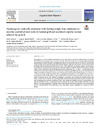Identificador persistente para citar o vincular este elemento:
https://accedacris.ulpgc.es/jspui/handle/10553/78009
| Título: | Physiological trade-offs associated with fasting weight loss, resistance to exercise and behavioral traits in farmed gilthead sea bream (Sparus aurata) selected by growth | Autores/as: | Perera, Erick Rosell-Moll, Enrique Martos-Sitcha, Juan Antonio Naya-Català, Fernando Simó-Mirabet, Paula Calduch-Giner, Josep Manchado, Manuel Afonso López, Juan Manuel Pérez-Sánchez, Jaume |
Clasificación UNESCO: | 310902 Genética 251092 Acuicultura marina |
Palabras clave: | Critical Speed Fasting Weight Loss Free-Swimming Behavior Growth Selection Maximum Metabolic Rate |
Fecha de publicación: | 2021 | Publicación seriada: | Aquaculture Reports | Resumen: | Three gilthead sea bream families representative of slow, intermediate and fast heritable growth in the Spanish PROGENSA® selection program were used to uncover the effects of such selection on energy partitioning through measurements of fasting weight loss, swimming performance and behavioral traits in one- and two-year-old fish. Firstly, selection for fast growth significantly increased fasting weight loss and decreased the hormonal ratio of circulating Igf-i/Gh in short-term fasting fish (17 days). This is indicative of a stronger negative energy balance that explains the reduced compensatory growth of fast-growing fish during the subsequent short-term refeeding period (7 days). Selection for fast growth also decreased the critical speed (Ucrit, 6–7 BL s−1) at which fish become exhausted in a swim tunnel respirometer. The maximum metabolic rate (MMR), defined as the maximum rate of oxygen consumption during forced exercise, was almost equal in all fish families though the peak was achieved at a lowest speed in the fast-growing family. Since circulating levels of lactate were also slightly decreased in free-swimming fish of this family group, it appears likely that the relative energy contribution of anaerobic metabolism to physical activity was lowered in genetically fast-growing fish. Selection for heritable growth also altered activity behavior because slow-growing families displayed an anticipatory food response associated with more pronounced daily rhythms of physical activity. Also, respiratory frequency and body weight showed and opposite correlation in slow- and fast-growing free-swimming fish as part of the complex trade-offs of growth, behavior and energy metabolism. Altogether, these results indicate that selective breeding for fast growth might limit the anaerobic fitness that would help to cope with limited oxygen availability in a scenario of climate change. | URI: | https://accedacris.ulpgc.es/handle/10553/78009 | DOI: | 10.1016/j.aqrep.2021.100645 | Fuente: | Aquaculture Reports [EISSN 2352-5134], v. 20, (Julio 2021) |
| Colección: | Artículos |
Citas SCOPUSTM
11
actualizado el 08-jun-2025
Citas de WEB OF SCIENCETM
Citations
11
actualizado el 08-jun-2025
Visitas
188
actualizado el 11-may-2024
Descargas
100
actualizado el 11-may-2024
Google ScholarTM
Verifica
Altmetric
Comparte
Exporta metadatos
Los elementos en ULPGC accedaCRIS están protegidos por derechos de autor con todos los derechos reservados, a menos que se indique lo contrario.
